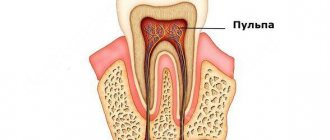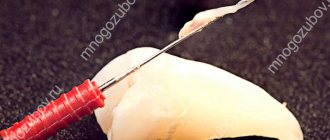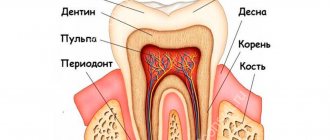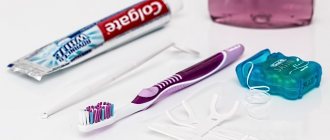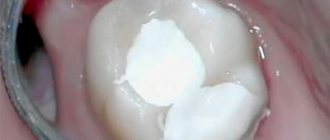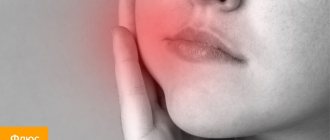Toothache is explained by the presence of a nerve - a process that connects the human nervous system with the dental crown.
If you have a pain syndrome, it is important to know how you can kill the nerve yourself at home using folk remedies (iodine, alcohol, vinegar, garlic, etc.), as well as how to quickly relieve pain at home with the help of medications, which will be discussed in detail Further.
What is a nerve and what is it for?
Human teeth consist of an outer bony part (crown) and numerous blood vessels inside.
Blood and lymphatic vessels, small fibers and a whole network of nerve endings are located inside - in the pulp, which is inaccessible to the human eye. Nerve fibers go far into the roots along the canal. This is the natural anatomical structure of the human tooth.
At human birth, the nerve is a catalyst for the process of growth and proper nutrition of the tooth. Afterwards, the function changes - the endings are an indicator of the ongoing destruction of the outer crown.
How long does it take to die
Killing the nerve is called a devitalization procedure. This relieves periodic pain when eating cold, hot or sweet foods. The nerve dies from a day to several days or even months - it all depends on the method used for this. If a special remedy is used, then you won’t have to wait long - the well-known arsenic neutralizes nerve endings within 24 hours or even less.
If the decision was made not to touch the entire destroyed tooth, then you will have to endure periodic unbearable pain for several months - killing occurs due to developing dangerous bacteria. It is prohibited to resort to such a method, because it is fraught with the formation of a cyst due to the discarded “waste” into the gums and pulp.
This is important: Devitalization involves stopping the nutrition of the tooth, so after some time the crown will darken. The way out of the situation is treatment - the use of a filling will close the exposed roots and gums, and also prevent darkening of the bone part.
In what cases is it necessary to kill him?
The dental nerve is killed in most cases for painless treatment. Moreover, deformation of the pulp - drilling the tooth to apply a filling - will subsequently provoke partial “exposure” of the nerve endings. As a result, even after treatment the person will experience pain.
Among all the reasons for killing the dental nerve are:
- prosthetics;
- deep carious cavity - when caries has affected the deep layers of the pulp;
- previous poor-quality dental treatment – pain occurred after dental intervention;
- mechanical injury.
Prerequisites also include inflammation of the pulp, developing periodontitis and other destructive processes of the dental crown.
In what cases is nerve removal indicated?
With pulpitis, the causative tooth reacts sharply to any mechanical and temperature stimuli. If the neurovascular bundle is already severely damaged, there is no point in trying to stop the inflammatory process, because the risk of relapse is too high. In such a situation, the doctor prescribes removal of the nerve - depulpation. Thus, among the main indications for this procedure, experts in the field of endodontics identify the following pathological conditions:
- advanced caries and pulpitis: when the lesion destroys enamel and dentin and reaches the pulp, it is necessary to either urgently stop the inflammation or remove the affected tissue. The first option is possible only in the early stages of pulpitis, but in practice it is more often necessary to partially or completely amputate the neurovascular bundle,
- complication after unsuccessful treatment in dentistry: in the process of preparing a too large carious cavity, there is always a risk of accidentally injuring the pulp. In such a situation, to correct the error, you also have to remove it partially or completely,
- prosthetics: to install fixed bridges and dentures, it may be necessary to depulpate the abutment teeth,
- mechanical injuries: the pulp can be damaged and inflamed also due to a strong blow. Large chips and cracks in the enamel often lead to similar consequences.
Removal of the nerve is indicated in the treatment of pulpitis
“They removed the nerve from my tooth, but that was a long time ago. Back then, a special medicine was put inside, and something like a temporary filling was placed on top. After 3-4 days you come back for an appointment, and the doctor is already pulling out the dead nerve. I remember while I was waiting for the next appointment, it was unpleasant, the tooth hurt, but it seemed like it should be. I heard that now this procedure is easier, they can do everything in one visit.”
Maxim_Volt, from correspondence on the forum www.32top.ru
Piercing pain in the tooth, which becomes especially unbearable at night, most often indicates the development of pulpitis. However, when the pathological process becomes chronic, acute symptoms may disappear completely. In this case, only a professional doctor can make a correct diagnosis in time. This is one of the reasons why it is so important to have a routine dental checkup every six months.
Symptoms
You can find out about the destruction of the pulp and the impact on the dental nerve by the existing unpleasant symptoms :
- prolonged pain - in most cases occurs after eating cold or hot, indicates inflammation of the pulp, tissue death;
- severe – acute pain can also cause the development of pulpitis, often indicating the formation of a crack in the dentin (the second layer of the tooth);
- aching - this type of pain indicates the beginning of destruction and partial exposure of the pulp;
- attacks - pain occurs only when pressure is applied to the tooth.
The formation of a characteristic unpleasant sensation when cold or hot is also noted. This occurs due to increased sensitivity of the tooth, which is the result of exposure of the nerve or root. Sometimes such symptoms indicate improper use of a toothbrush or the use of inappropriate toothpaste, which gradually leads to abrasion of the enamel.
Price
The cost of treating pulpitis is higher due to the use of expensive drugs and visits to the clinic 2-3 times.
The price is affected by the number of channels, which depends on the type of tooth (incisor, canine, molar). The equipment used during the operation also affects the final cost. The same applies to the stage of the disease, treatment method, and additional procedures for aesthetic tooth restoration.
| Included in the price |
|
| Paid separately |
|
Sometimes simple caries, which does not cause too much pain, goes unnoticed. A potential patient does not turn to a specialist for help, believing that the cessation of pain indicates the disappearance of the problem. However, this rarely happens with dental injuries. Most often, developing caries continues to destroy tooth enamel and ultimately leads to the occurrence of pulpitis - inflammation of the neurovascular bundle that fills the tooth cavity.
Pulpitis usually manifests itself with severe pain. At the initial stage, these may be painful reactions to food of different temperatures. The pain usually intensifies at night, occurs in attacks and is not always localizable (it is not possible to immediately determine which tooth hurts). Pulpitis can occur in acute and chronic forms.
How dentists do it
For devitalization, it is better to contact dentists, who will conduct a thorough examination, determining the cause of the toothache. Specialists use special means to quickly kill the nerve and stop the patient’s suffering.
Arsenic pastes
Arsenic is the most common dental nerve killer used in dentistry. Previously, it was used in its “pure” form, mixed with suitable additives.
Today we offer ready-made formulations :
- Devit-ars - promotes rapid neutralization of the nerve, has an analgesic effect due to the content of lidocaine hydrochloride. The mixture is applied for a day, but with a special tooth structure, exposure is required for 2 days.
- Kaustinerv Rapid - the main component in the form of arsenic anhydride is contained in only one third of the presented composition. The rest is lidocaine, menthol, phenol and other additives. As a result, it is used to kill the nerve for 2-3 days.
- Septodont is a paste with a wide range of effects, actively used for the treatment of periodontitis. Has antibacterial and antifungal effects.
- Pulparsen - one third consists of the main substance arsenic, contains the antiseptic camphor.
- Causticin is also one third of arsenic anhydride, the rest is reserved for antiseptic and analgesic substances. Use to neutralize the dental nerve for at least 2 days.
Devit Ars Kaustinerv Septodont
Attention: The use of arsenic-based products must be carried out in strict compliance with the instructions and only with the permission of a doctor. Violation of recommendations may lead to irreversible consequences for human health.
Arsenic-free pastes
Such drugs include Devit-P and Devit-S . These agents are based on paraformaldehyde, lidocaine has an anesthetic effect, and creosote has an antimicrobial effect. Due to the fact that the drugs do not contain arsenic, their use takes place within 10 days.
Devit P Devit S
The advantage of the presented products is the absence of a substance dangerous to the human body and the need to clean the dental canal before treatment.
Process steps
Once the medication is applied to the exposed pulp, the process of neutralizing the dental nerve begins. Due to the influence of basic substances, cell respiration is impaired, resulting in decomposition of the constituent nerve branches.
Watch how a nerve is removed in dentistry:
Depulpation in a clinical setting
The procedure is most often painless, since before it the patient is injected into the gums with modern anesthetic drugs. It is possible to heal a diseased tooth in one visit to the dentist without using products containing arsenic.
Stages of the dental depulpation procedure:
- puncturing the gums located next to the diseased element with anesthetics;
- expansion of the channel 15 minutes after drug administration;
- treatment of the oral cavity with disinfectants;
- removal of the nerve using special dental equipment;
- repeated mouth antiseptics and filling of the root canal of the pulpless element.
If there are any problems with the operation, the dentist will heal the tooth according to a different scheme. After cleaning the canals, a medicine is placed into the carious cavity, which has an effect similar to arsenic, but is less dangerous for humans. After complete removal of the nerve endings, the doctor performs secondary cleaning of the canals. Permanent composite material is installed only after complete destruction of the nerve and cleansing of the canals from necrotic masses.
After the intervention, soreness of the unit and swelling of the soft tissues near it can be observed for 2-3 days. If the problem is accompanied by acute throbbing pain and fever, you should immediately consult a doctor again.
How to kill with drugs
The use of the above products requires careful preparation, and then high-quality dental treatment.
The entire process of nerve removal includes the following steps:
- Opening the tooth - it is necessary to fully expose the pulp.
- Application of medication and temporary filling.
- Removing the applied composition, cleaning the canals, if necessary.
- Additional disinfection.
- Filling or other type of treatment.
- Control photo.
If you have severe pain, it is recommended to consult a dentist to identify the causes and develop appropriate treatment. Otherwise, you can only make the situation worse.
What to do when the nerve is removed?
After depulpation at home has been carried out, you need to thoroughly clean your mouth with running water and go to the dentist. If the dead pulp is not removed in time, it can lead to osteonecrosis of the jaw.
After the procedure, it is recommended to rinse your mouth with medicinal herbs, which help relieve inflammation and prevent infection. Chamomile is suitable for these purposes. But you shouldn’t delay going to the dentist; this should be done no later than two weeks after the nerve is removed.
Preparing for the procedure at home
Self-killing a nerve at home begins with preparation, which takes place in the following sequence :
Brushing your teeth – It is important to thoroughly clean your teeth, especially the one that will be treated. When brushing, all actions are smooth and without pressing with a toothbrush - this can provoke a new attack of pain.
Disinfection of available instruments - applying a paste or other product can be done in different ways using the most unexpected tools. All used items must be disinfected with alcohol or vodka.
Cleaning the hollow of a tooth - take a needle or thin wire and clean with careful and leisurely movements.
Rinsing the tooth with an antiseptic - after all procedures, the oral cavity is simply rinsed with a special antiseptic solution.
After the preparation has been completed, they begin to search for a tooth that has no prospects for treatment. To do this, touch each person with a cooled cotton ball, “listening” to the pain syndrome. If the pain is severe but short-lived, then the tooth should be treated by a dentist. If the pain goes away only after a few minutes, the tooth can be “finished off.”
How to properly prepare for house removal?
Before answering the question of how to remove a dental nerve at home, you need to prepare for this procedure:
- Clean the canals well to prevent suppuration. This can be done with a toothbrush and toothpaste, removing plaque and all food debris.
- Take a needle, disinfect it in alcohol and clean the hollow in the tooth with the non-sharp side.
- Use chamomile decoction to rinse your mouth or apply a special dental elixir.
Only after such manipulations can you begin to remove the nerve.
Is it possible to kill a dental nerve at home? Yes, you can, but this does not mean that the work is over and you can live without worrying about anything. After the procedure, it is necessary to remove the nerve fibers, otherwise infection may begin.
How to kill an open dental nerve yourself at home
There are several ways to remove the nerve yourself, which is carried out after the preparation presented above.
Here you can use:
| Powder | A few grains are simply poured into the open channel. The method is dangerous to use because it entails corresponding intoxication. |
| Zinc | It is obtained from printing house ink by burning a small piece of newspaper. For the procedure, you need to use an anesthetic - drink Ketanov, apply Baralgin. Afterwards, a moistened cotton ball is dumped in the ashes of the burnt newspaper until it reaches a black color. Afterwards, you need to put it in the tooth and cover it with a clean one. |
| Alcohol | A cotton ball is soaked in alcohol and placed in the exposed tooth. You can prepare a solution - mix alcohol with water in a 1:1 ratio and rinse your mouth with it. This way you can relieve pain for a short time. |
| Vinegar | For killing, only 6% product is used. A ball of cotton wool is also soaked in it and placed in the tooth. You should be careful when using this method, since vinegar can cause burns to the mucous membranes. |
| Arsenic | Using this method is strictly prohibited at home. Here you need to use special medicines on arsenic bases. |
| Iodine | A cotton ball soaked in iodine is placed into the tooth and left for a day. |
Of all these methods, iodine is the safest. It is used carefully, monitoring the position of the cotton temporary filling - it is necessary to prevent the product from getting on the gums and mucous membranes.
The nerve has died - how to remove it at home?
You will not be able to remove the nerve yourself at home. It is better to consult a doctor who will use a special pulp extractor. Home removal can lead to disruption of the integrity of the nerve, which may cause the pain to recur.
Please note: Some people, having killed a nerve at home, try to remove it themselves using a regular needle. This method is theoretically correct, but in practice it always leads to complications.
Seeing a dentist even after self-killing a nerve is not a mistake; no punishment will follow for this. Only a specialist will assess the condition of the tooth.
Watch the video about why it is dangerous to kill a nerve at home:
Dental nerve - what is it?
In fact, the nerve in the tooth is the pulp. It is surrounded by dentin, which covers the enamel on top. This part of the tooth is responsible for nourishing all other tissues, as well as for sensory perception. Therefore, after its removal, the crown usually fades, acquires a grayish tint, and becomes fragile and brittle. Such a tooth is called dead.
The pulp is a bundle of blood vessels and nerves of the tooth.
As soon as carious processes penetrate deeper into the dentin and reach the pulp, the person begins to experience severe piercing pain. In this case, doctors usually make a diagnosis of pulpitis. But this disease can also be traumatic. With a strong blow, the pulp is damaged and becomes inflamed. If treatment is not started in time, the nerve will have to be partially or even completely amputated. This is necessary to prevent further spread of the inflammatory process and the development of complications, including periodontitis.
The safest folk methods that will help calm the nerve and relieve pain
There are safer methods used at home to devitalize the dental nerve.
These include:
| Salt | This method involves using a saline solution to rinse your mouth. To prepare, mix a teaspoon of salt in a glass of warm water. This treatment will relieve pain in the inflamed nerve of the tooth for a short time. |
| Salt and garlic | A clove of garlic is ground into a paste and mixed with a small amount of salt. Next, the resulting mixture is placed into the open canal (hole in the tooth) until the pain syndrome is completely eliminated. |
| Comfrey flower | Make a root tincture - for this, 10 g of the main component is poured with 50 ml of alcohol and left for 10 days. A cotton ball is soaked in the tincture and placed in the tooth canal. |
| Propolis | Pour 30 g of propolis into 200 ml of alcohol and leave the mixture for 10 days. The finished tincture can be purchased at the pharmacy. Soak a cotton ball in the solution and place it in the tooth until the pain disappears. |
| Hydrogen peroxide | Use a 3% hydrogen solution, diluting it in water in a ratio of 2:1. A cotton swab is also soaked in the resulting liquid and applied to the exposed nerve. |
| Onion peel | It is used to prepare a decoction that can be used to rinse your mouth to get rid of pain. Pour about 30 g of husk into half a liter of boiling water and put on fire, bring to a boil, boil for 5 minutes. Then the broth is removed from the heat and kept for another 2 hours. Afterwards you can use it as directed, it will help calm the nerve and reduce pain. |
| Clove essential oil | Ready-made oil is purchased at a specialized store. A drop of the product should be placed on a cotton pad and applied to the sore tooth. |
| Lilac | An effective spring remedy. It is necessary to collect the leaves, chop them and pour half a liter of boiling water in the amount of 30 g. Then put on fire, bring to a boil, turn off the heat and leave for 2 hours. Simply rinse your mouth with the resulting decoction. |
| Wheat | If a toothache occurs, you need to drop the juice squeezed from the grains into the lesion. |
| Herbal infusions | Here you can use chamomile, lemon balm, cloves, sage, mint and oak bark for preparation. Rinse your mouth with the prepared infusions immediately when pain occurs. This recipe notes that it is better to use a warm infusion for processing. |
| Pepper | Pepper and salt mixed in equal quantities must be poured into the resulting hole. |
All the given recipes for killing the dental nerve are used immediately when pain occurs. Keep tampons and components in the canal until pain is completely eliminated.
Is it possible to kill a nerve yourself using traditional methods?
Many people are interested in the question of whether it is possible to kill the pulp on their own at home and what folk remedies are best to use for this. The answer will be categorical: such serious dental procedures should be performed by a professional doctor, and nothing else. Otherwise, you risk only aggravating the situation and provoking the development of serious complications.
Therefore, below, for informational purposes only, are the old methods that were previously popularly used to kill a tooth. Here's what they used to kill the nerve, except for arsenic:
- vinegar - moisten a piece of cotton wool in vinegar essence and apply to the causative tooth. Great care should be taken as the essence quickly corrodes enamel and dentin,
- gunpowder - place the substance into the carious cavity, but under no circumstances swallow it, as this can lead to serious poisoning,
- iodine – moisten a piece of cotton wool with iodine and apply it to the hole. You just have to prepare for the fact that it will hurt very, very badly,
Iodine is also used in folk medicine - zinc - burn a piece of newspaper with black ink, collect the ashes on a cotton swab and place it as close to the nerve as possible, leaving it there for about 12 hours,
- arsenic - place a pea of a toxic substance into a cavity in a tooth. It is very easy to fail to calculate the dosage, which can result in serious poisoning of the body and even death.
Under no circumstances should you try to use these methods on yourself. Contact your dentist and undergo the appropriate procedure under the supervision of an experienced specialist. Independent attempts are fraught with dangerous complications.
How to relieve pain with medications
If you do not want to deal with the above methods of tooth pain relief, you can use ready-made medications. All of them are intended only to eliminate pain; devitalization of the dental nerve does not occur in this case.
The most popular means include:
| Ketones | The most effective medicine for pain relief. Approved for use only by adults, it has a large number of contraindications. |
| Ketorol | An analogue of Ketanov with the same positive properties. It has many contraindications, which include diseases of the respiratory system, liver disorders, and stomach pathologies. |
| Took | Can relieve pain of moderate intensity. For people with increased hypersensitivity or during pregnancy, it is better not to take it. |
| Moment | Recommended for use to relieve inflammation and relieve pain. Dangerous for use during pregnancy and lactation; not recommended in the presence of ulcers or any pathologies of the circulatory system. |
| Solpadeine | Recommended for use when it is necessary to quickly relieve pain and inflammation. Do not use if you have problems with blood pressure. |
| It is based on valerian tincture and contains additional substances. Effective in the presence of mild pain. The drug is used to rinse a diseased tooth. | |
| Validol or Carvalol | They belong to the group of emergency drugs. A cotton ball is soaked in one of these products and applied to the diseased tooth. |
This is important: The products presented must be used in accordance with the instructions from the manufacturers. It is important to exclude the presence of contraindications.
Popular questions
Toothache often contributes to panic in the patient, which is why the most common questions are asked:
- The pain does not go away, what should I do? First, you should calm down and use another recipe to eliminate pain. If nothing helps, no matter how many remedies you try, you need to see a dentist.
- Arsenic does not kill the nerve, why and what to do? There may be several reasons for this - improper use or poor quality of the drug. It is recommended to change the arsenic-based product and increase the duration of exposure. If arsenic was applied by a doctor, you must contact him again for consultation.
- How to kill a tooth root? The root of the tooth cannot be killed; it should only be removed. This is often resorted to when a bone part is completely destroyed or in case of inflammation.
- Can a nerve in a tooth die on its own? The nerve can die on its own, but this will take a long time. Often its sensitivity is dulled, but when exposed to an “aggressive” component, the pain resumes.
- Is it possible to kill the dental nerve with analgin? Analgin and other similar drugs only eliminate pain, but cannot kill the nerve completely. When the effect of the pill wears off, the tooth will begin to hurt again.
- How do you electrocute a nerve? This method was used several years ago. According to patients, the procedure is unpleasant and quite painful. A special device was applied to the exposed nerve, which sent a charge of current. Microcurrent exposure led to cell death and burning of nerve vessels. As a result, its sensitivity decreased, and the removal was painless.
There are many issues of interest to people who prefer to solve all their problems at home rather than visit villains in white coats. However, a full consultation can only be obtained by visiting a dentist.
Dentist about removing a nerve in a child’s tooth:
Modern methods of tooth nerve removal
Nowadays, removing a nerve from a tooth in the dentist’s chair takes only one visit. In addition, it is absolutely painless - anesthesia is used during dental treatment, and does not entail any discomfort after the procedure, except for a short time.
The process of nerve removal begins in the same way as the process of caries treatment. After an anesthetic injection, the doctor provides access to the pulp, removing the affected material. Then the pulp is removed from the tooth, for which the dentist has special tools. The procedure takes approximately 40 minutes, but may be longer if complications exist.
After the nerve is removed, the tooth and dental canals are filled as in the treatment of periodontitis. Sometimes the doctor decides to play it safe and puts a temporary filling to make sure that the depulpation was successful. If no problems are observed at the next scheduled visit to the dental clinic, a permanent filling is installed.
Sometimes the nerve is only partially removed when inflammation affects only the coronal part of the pulp. In this case, the tooth is also opened, necrotic tissue is removed, and the coronal part of the pulp is cut off. As a result, the root part of the pulp is preserved.
This method can be used in the case of dental treatment in children, when it is important to preserve the root part of the pulp, because it forms the roots of the tooth. In addition, if the nerve of a tooth is only partially removed, it will deteriorate more slowly. The decision as to whether only part of the nerve can be preserved is made by the dentist after examining the oral cavity.
Is it painful to remove the nerve of a tooth?
No. Modern dentistry allows you to perform all procedures absolutely free. In addition, the use of modern equipment and innovative materials minimizes the time it takes for a tooth to “get used” to fillings.
Until recently, surgery to remove a nerve from a tooth was very painful. For these purposes, arsenic was used, which did not give any analgesic effect. The entire procedure took several visits to the dentist. In old videos you can see how the following algorithm of actions is performed:
- The root canal was expanded using a drill. The nerve was exposed and arsenic was placed into it.
- The canal was closed with a temporary filling for 2 days. During this time, the nerve had to die, and this process was very painful, when even strong analgesic drugs were unable to relieve the pain.
- Afterwards, the patient returned to the dentist. He removed the temporary filling and removed the pulp.
- Next, the root canals were cleaned. By this time, the pulp may not necessarily have completely died, so the patient again experienced pain.
Thus, the old treatment option had 2 disadvantages:
- Excessive pain in the process.
- The use of a strong poison - arsenic. The main danger with this is that if it is left in the tooth for more than two days, the tissue could be completely destroyed and the tooth will have to be pulled out.
Now this method is used extremely rarely. Modern clinics use much less painful methods of pulp removal, and, despite the fact that the process cannot yet be called pleasant, it is still possible to endure dental treatment.
Depulpation can take place as follows:
- First, the patient takes an x-ray, which will allow the doctor to determine the length and branching of the root tubules, knowing the depth of the filling. As an alternative, a modern device helps, which allows you to illuminate the tooth.
- A local anesthetic is injected to relieve tooth sensitivity. Sometimes the patient undergoes general anesthesia.
- Next, the nerve itself is removed.
- The final stage is filling the tooth with a permanent filling. Sometimes a temporary filling may be placed, which will be replaced during a re-examination.
In most clinics, repeat x-rays are taken to confirm the successful outcome of the operation. Depulping takes about an hour. In the future, you will need two or three preventive visits to the dentist.
